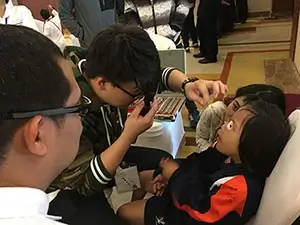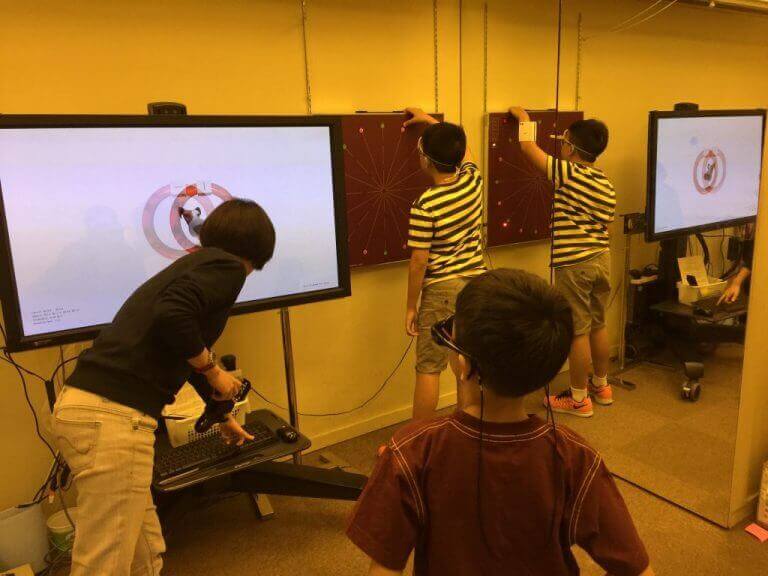Services
DOWN SYNDROME
VISION CHALLENGES IN CHILDREN WITH DOWN SYNDROME: ADDRESSING SPECIAL NEEDS
Children with special needs such as Down Syndrome experience similar vision challenges as neurotypical children, including conditions like nearsightedness (Myopia, Rabun Jauh) or farsightedness (Hyperopia, Rabun Jauh), as well as eye-coordination disorders such as eye turns (Strabismus, Mata Juling 斗鸡眼/斜视), eye movement dysfunction, “lazy eye” (Amblyopia, Mata Malas 懒惰眼), and poor eye teaming and coordination. These conditions can lead to a distorted perception of what they see, affecting depth perception and other aspects of visual information processing.
Such vision problems associated with Down Syndrome can compound the challenges these children face. Undiagnosed visual issues can impact their behavior, hinder their ability to read and learn, and make routine tasks more difficult.

VISION PROBLEMS ASSOCIATED WITH DOWN SYNDROME OFTEN GET OVERLOOKED
Children with special needs frequently find it challenging to remain still during a standard eye examination, potentially leading to inaccurate or incomplete assessments. Additionally, some children may experience intermittent rather than constant eye turns, which can go unnoticed. Conventional eye chart exams primarily gauge distant vision at 20 feet, often overlooking issues with close-up vision, like reading words in a book. Furthermore, since children may not be aware of how they are supposed to see, they often do not voice complaints, concealing certain vision problems.
VISUAL-PERCEPTUAL DELAYS
It’s no surprise that visual-perceptual delays are frequently observed in children with Sensory Integration Dysfunction. Visual-perceptual skills encompass a person’s capacity to interpret, analyze, and attribute meaning to what they observe. Interestingly, more than 70 percent of students considered ‘underachievers’ encounter challenges in processing visual information, even when they possess 20/20 eyesight.
The Role of Visual Attention in Child Development
Visual attention is the ability for a child to concentrate on their current task while filtering out extraneous stimuli. A child prone to distractions may struggle to sustain visual attention. During reading, some children are compelled to scan the entire page, diverting their focus from the specific words they should be reading. Certain kids may encounter difficulties in shifting their visual attention and comprehending the information they are observing. Some might not even notice events occurring around them. A child with visual hyporesponsiveness may find it challenging to detect visual stimuli or maintain visual interest, often becoming fatigued quickly. Those who do not pay adequate visual attention may miss crucial developmental opportunities since they fail to absorb and process the surrounding information.
Importance of Visual Discrimination in Child Development
Visual discrimination empowers a child to recognize distinct characteristics of objects, such as color, shape, size, and orientation, facilitating object matching and categorization. As a child matures, they gain the ability to differentiate between various shapes like triangles and circles, or distinguish between uppercase ‘B’ and lowercase ‘b’. Children with visual discrimination issues may struggle to recognize faces or differentiate between a rectangle and a square.
Visual Discrimination, Visual Memory and Figure-Ground as Essential Skills
Visual discrimination empowers a child to recognize distinct characteristics of objects, such as color, shape, size, and orientation, facilitating object matching and categorization. As a child matures, they gain the ability to differentiate between various shapes like triangles and circles, or distinguish between uppercase ‘B’ and lowercase ‘b’. Children with visual discrimination issues may struggle to recognize faces or differentiate between a rectangle and a square.
Visual memory plays a vital role in a child’s ability to recall things they have seen, which is essential for tasks like mimicking gestures and movements, sequencing writing and spelling exercises, recognizing words and people, and more. Insufficient visual memory might lead to a strong memory for life experiences but difficulties in recalling factual information, making it challenging to relate new visual information to their existing knowledge.
Figure-ground perception is crucial for distinguishing between the foreground and background, helping a child maintain focus on important visual stimuli while ignoring distractions. For instance, this skill enables them to locate their favorite toy in a box filled with other items and stay attentive to the teacher in a bustling classroom. Children facing figure-ground difficulties may encounter reading problems since they struggle to differentiate specific words on a page while reading.

Understanding Visual Closure, Form Constancy, Laterality, Directionality and Spatial Vision
Visual Closure enables a child to identify objects by using visual cues without requiring a complete image. For example, this skill allows them to locate a partially concealed lunchbox behind a milk carton or recognize an entire word even when they’ve only seen a part of it, a capability proficient readers often exhibit without the need to scrutinize every letter.
Form Constancy empowers a child to perceive objects as identical regardless of variations in their environment, position, size, or other details. For instance, they can recognize a spoon as a spoon regardless of whether it’s upside down, turned sideways, or made of different materials like silver or plastic. In an educational context, Form Constancy helps children understand that the letter ‘S’ remains an ‘S’ whether it’s handwritten, typed, in print, cursive, or displayed sideways.
Laterality, Directionality, and Spatial Vision:
Laterality allows a child to distinguish between the right and left sides of their own body. Directionality extends this perception to external objects, helping the child identify the right and left sides of objects in their surroundings. Both skills are crucial for spatial vision, which enables the child to understand how objects are positioned in space. For instance, these skills help a child differentiate between the lowercase ‘b’ (with a line on the left side) and ‘d’ (with a line on the right side). A child with poor spatial vision, such as those with Down syndrome, may face difficulties in playing with toys, mastering tasks like climbing stairs or catching a ball (which require depth perception), and developing essential self-care skills. They may also struggle with persistent letter reversals, experience confusion with letter or number sequences, and find it challenging to understand directional words like ‘up,’ ‘down,’ ‘in,’ ‘out,’ ‘under,’ ‘over,’ and may exhibit poor topographical orientation and easily become disoriented.
Furthermore, a child must develop their Visual-Motor Integration skills, where their eyes and body work in coordination to complete various developmental tasks, ranging from stringing beads to catching a ball. These skills are commonly referred to as eye-hand coordination skills and encompass the interaction of motor skills, visual skills, and visual-perceptual skills.”
IDENTIFYING SIGNS AND SYMPTOMS OF VISION PROBLEMS IN SPECIAL NEEDS CHILDREN
If you notice any of the following signs and symptoms in your child, it could be an indication of an undiagnosed and treatable vision issue associated with Down syndrome:

- Skips or repeats lines while reading
- Omits small words when reading
- Exhibits poor reading comprehension
- Homework takes longer than expected
- Displays reduced visual attention
- Struggles to maintain focus while reading
- Has difficulty completing assignments within deadlines
- Faces challenges when copying from the board
- Experiences burning, itchy, or watery eyes
- Tilts their head or closes one eye while reading
- Frequently closes or covers one eye
- One eye turns inward or outward
- Avoids near work, such as reading
- Finds it challenging to listen and look simultaneously
- Holds reading material too close
- Demonstrates poor handwriting
- Appears clumsy and frequently knocks things over
- Suffers from car or motion sickness
- Adopts unusual neck and body postures
- Exhibits visual perceptual problems
- Has a short attention span
- Experiences uncontrolled eye shaking (Nystagmus)
Recognizing these signs and symptoms is crucial for early intervention and addressing potential vision challenges in special needs children.
